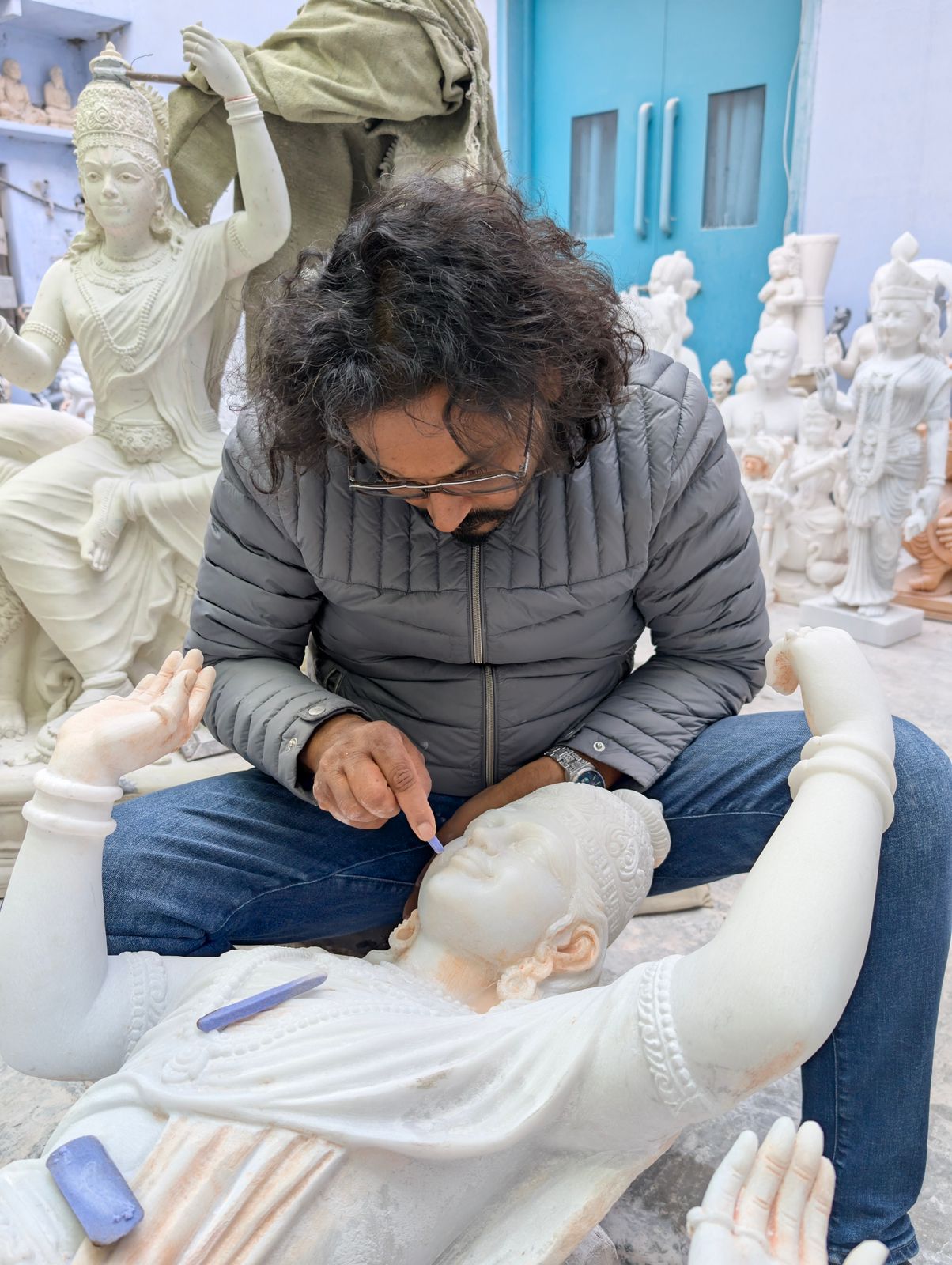The majestic idols at the Ayodhya Ram Temple are not just beautiful sculptures—they are embodiments of deep faith, sacred craftsmanship, and timeless tradition. Behind every idol lies a painstaking process that combines spiritual devotion with exceptional artistry passed down through generations. These murtis are not made in haste but shaped through rituals, care, and unwavering dedication.
From the careful selection of high-quality marble to the detailed chiseling by expert artisans, every step in the making of idols like the Ram Laxman Sita marble murti temple or the Hanuman ji marble moorti is performed with devotion and reverence. Let’s explore how these divine figures come to life before gracing one of India’s holiest temples.
1. Selecting the Sacred Marble
The journey of a Ram Mandir marble murti begins at the very root—choosing the right marble. Not just any stone can be used; artisans, often from Jaipur and surrounding areas, seek out premium-quality Makrana marble, known for its purity, strength, and natural sheen. The marble is assessed for color, grain, and absence of impurities, as these factors directly affect both the beauty and sanctity of the idol.
For religious sculptures destined for sacred places like the Ayodhya Ram Temple, the stone must be flawless—symbolizing the untainted and divine nature of the deity. This stage often involves spiritual rituals and prayers, asking blessings before cutting the marble block.
2. Spiritual Planning and Measurements
Before a single strike of the chisel, artisans and spiritual guides come together to finalize the dimensions and posture of the idol. Ancient scriptures like the Shilpa Shastra and Agama texts are consulted. Every expression, gesture, and symbol—from Ram’s calm eyes to Hanuman’s folded hands—is meticulously planned.

When creating a Ram Laxman Sita marble murti, it’s not just about symmetry—it’s about emotional accuracy. Sita must embody grace, Laxman devotion, and Ram dharma. Similarly, a Hanuman ji marble moorti should reflect humility, strength, and unwavering faith. The divine posture and facial expressions must match the divine characteristics.
3. Skilled Carving by Master Artisans
The real magic begins when sculptors, often from artisan families in Jaipur, start hand-carving the idols. These artisans may spend months, sometimes even a year, working on a single idol. It’s not only about skill—it’s a spiritual duty.
Each carving session begins with chanting or lighting incense, invoking divine blessings. These moments reflect that idol-making is not a mechanical task but a devotional process. The murti is shaped gradually—starting from rough outlines to intricate details like the folds of the garment, the tilt of the head, or the texture of the crown.
Many temples and even individuals now reach out to Customize murti manufacturers in Jaipur to get personalized designs aligned with scriptural references and specific deity forms. Pandey Moorti Bhandar is one such trusted name known for its authentic hand-carved idols with spiritual and aesthetic perfection.
4. Sanding, Polishing, and Painting
Once the main carving is done, the idol undergoes fine sanding to smooth out surfaces and edges. This helps remove chisel marks and sharp points while retaining the character of the design. The polishing brings out the natural glow of the marble, which is symbolic of divine brilliance.
Some idols remain in pristine white, while others are lightly painted using natural colors, especially the eyes and ornaments, to give a lifelike aura. The Ram Mandir marble murti often reflects the subtle grace of Lord Ram’s complexion, and the natural shine of the marble symbolizes his inner purity and nobility.
5. Ritualistic Blessings Before Installation
The final step in the process is the most sacred—ritual purification and blessing of the idol. Priests perform “pran pratishtha,” a spiritual ritual where the divine energy is invoked into the murti. Without this, the sculpture is considered only stone, not a deity.
Especially for an installation at the Ayodhya Ram Mandir, these ceremonies are conducted with grandeur and extreme sanctity. The idols are bathed in holy water, decorated with flowers, and offered sacred chants. Only after these rites are they transported to the temple and placed on the sanctum.
The Role of Jaipur in Supplying Divine Craftsmanship
Jaipur has long been the hub for crafting religious idols. It’s home to several expert artisans and renowned murti houses like Pandey Moorti Bhandar, known for their legacy in sculpting divine figures. The demand for customized work is rising, and many temples and spiritual institutions now look to Jaipur for Customize murti manufacturer in Jaipur to meet their specific needs with authenticity.
Whether it’s a towering Hanuman ji marble moorti or a graceful trio of Ram Laxman Sita marble murti, Jaipur’s craftsmen honor both tradition and technique. Their dedication ensures that each piece serves not just as decoration but as a focal point of spiritual experience.
Conclusion
The making of idols for the Ayodhya Ram Temple is a divine process rooted in scripture, guided by tradition, and executed with love and spiritual reverence. These are not just statues; they are living symbols of belief and devotion. Every step, from marble selection to consecration, is steeped in sanctity.
If you’re looking for finely crafted, spiritually accurate idols for your home or temple, trusted names like Pandey Moorti Bhandar in Jaipur are where devotion meets craftsmanship. Whether you’re seeking a Ram Mandir marble murti or wish to connect with a Customize murti manufacturer in Jaipur, the tradition continues—one divine sculpture at a time.

